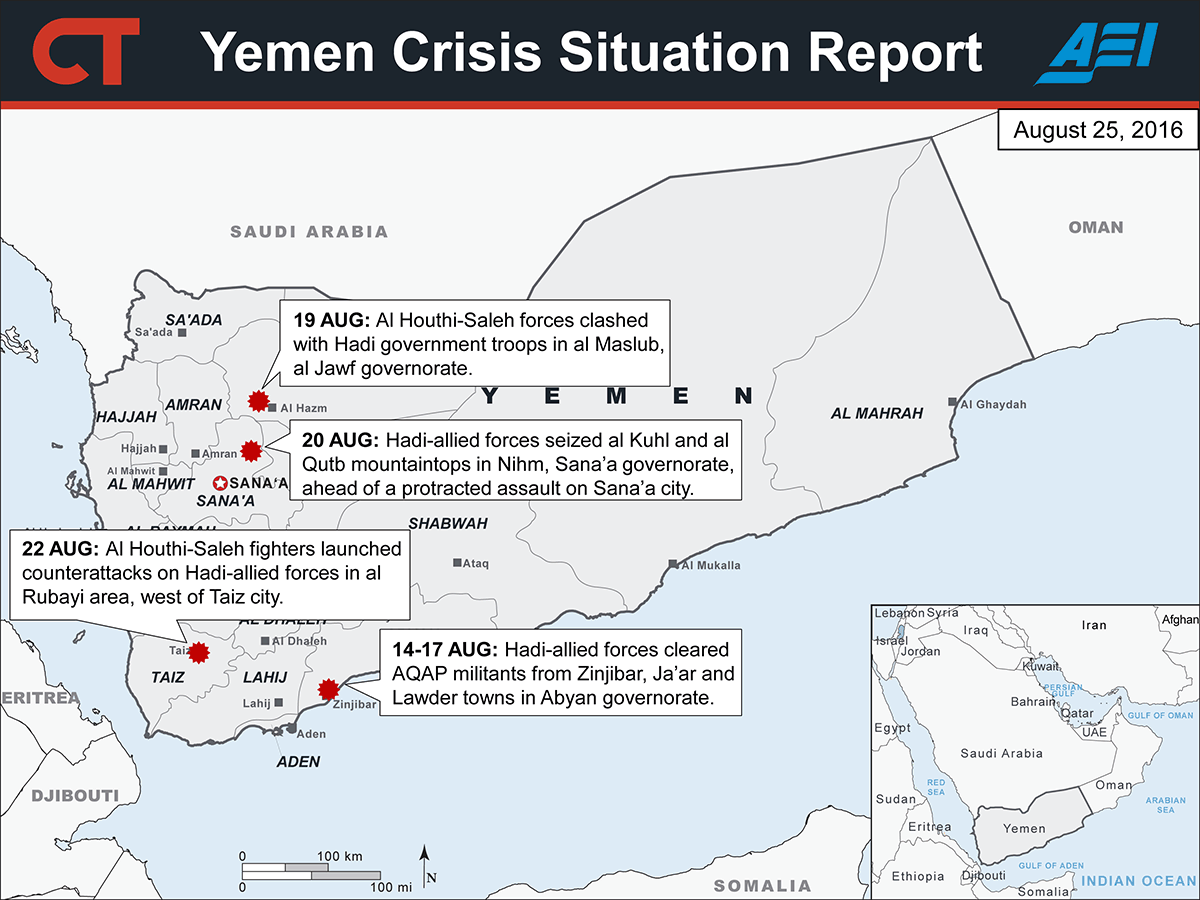AQAP demonstrated it has preserved its capabilities to conduct asymmetrical attacks after losing control of territory in southern Yemen. The group resurged after losing ground in 2012, too. Members of AQAP’s insurgent arm, Ansar al Sharia, reported carrying out a complex attack targeting al Houthi officials in Sana’a on August 19, killing 12 al Houthi members. (Claim obtained through SITE.) AQAP released a video on August 21 detailing training exercises and attacks on al Houthi-Saleh fighters in al Bayda governorate. (Video obtained through SITE.) Hadi-allied military forces supported by the Saudi-led coalition entered Shaqra, Zinjibar, and Ja’ar cities, Abyan governorate on August 14 to conduct clearing operations. An AQAP militant detonated a suicide vehicle-borne improvised explosive device (SVBIED) targeting Hadi-allied forces in Shaqra on August 15, killing at least four soldiers. Hadi-allied popular resistance forces cleared Lawder city, Abyan governorate of AQAP militants on August 17. An AQAP fighter detonated an SVBIED targeting troops in Lawder district on August 18, killing at least three soldiers. AQAP is unlikely to contest control of the cities directly. Ongoing attacks will prevent Hadi-allied forces from securing Abyan governorate. Reported U.S. airstrikes in Shabwah and Ma’rib governorates killed 11 AQAP militants on August 24.
Russia is engaging both the al Houthi-Saleh alliance and the Hadi-led government opportunistically to expand Russian influence in the Arabian Peninsula. Russia would be unlikely to prioritize formal relations with the al Houthi-Saleh alliance over its interests with Saudi Arabia under current conditions, however. Russia rejected a UN Security Council pronouncement that was “in support of the political process” on August 3, citing language overtly critical of the al Houthi movement. The Russian Foreign Ministry urged parties to commit to a ceasefire and return to UN-led peace talks on August 11. The Russian Charge d’Affaires for Yemen, Oleg Dremov, then attended the ceremony formalizing the al Houthi-Saleh Supreme Political Committee (SPC) on August 15, calling the body a “realistic authority” that “widens the base of popular legitimacy.” Russian Deputy Foreign Minister Mikhail Bogdanov repeated earlier Russian support for the UN-led peace process on August 21 after a series of meetings with the Saudi Deputy Crown Prince and other Saudi leaders. The al Houthi-Saleh alliance continues to take steps to establish itself as a state government. Former Yemeni president Ali Abdullah Saleh offered the Russian government access to Yemen’s bases, airports, and ports on August 21, citing shared interests in “combating terrorism,” for example.
Al Houthi-Saleh forces continue to build and launch locally made rockets targeting southern Saudi Arabia. An August 15 al Arabiya article asserted that al Houthi-Saleh forces used “Iranian-made solid propellant missiles” in a recent attack on southern Saudi Arabia, a claim rejected by the Islamic Republic News Agency (IRNA). Al Houthi fighters are building Zelzal-3 rockets inside Yemen, as confirmed by Iranian and al Houthi news outlets. The al Houthi-assembled versions are shorter, lighter, and less aerodynamic compared to conventional Iranian Zelzal-3 missiles. Al Houthi-Saleh fighters fired a locally made Zelzal-3 rocket at areas in Najran city, Saudi Arabia on August 23, demonstrating a continued ability to strike Saudi positions. It is not clear whether Iran or Iranian proxies like Hezbollah supported the construction of Zelzal-3 missiles inside Yemen. Iran has provided al Houthi forces with materiel support in the past.
Hadi-allied forces are unlikely to retain recent gains in Taiz, Yemen’s third-largest city, and have been fixed in Yemen’s central governorates. Hadi-allied forces are attempting to advance along the city’s western and southern fronts. Hadi-allied forces advanced in parts of western Taiz on August 19, but al Houthi-Saleh fighters launched counterattacks in Hidhran and al Rubayi areas, western Taiz city on August 22. Strong al Houthi-Saleh resistance will prevent Hadi-allied forces from seizing and holding Taiz city. Hadi-allied forces have failed to advance significantly along other front lines in al Dhaleh, al Bayda, and Ma’rib governorates, despite ongoing clashes with al Houthi-Saleh fighters in those areas.
Hadi government forces continue shaping operations northeast of Sana’a city for an offensive on the al Houthi-Saleh–held capital. Hadi-allied forces seized al Kuhl and al Qutb mountain positions in Nihm district, northeast of Sana’a city, on August 20, though al Houthi-Saleh fighters continue to contest other areas in Nihm. Hadi’s vice president, Lieutenant General Ali Mohsen al Ahmar, inspected troops in Nihm on August 15, and visited army units in Ma’rib and Shabwah governorates, east of Sana’a governorate, on August 24 and 25. Ali Mohsen’s presence among the troops that would be involved in the Sana’a offensive is an indicator that it may begin soon, as well as the use of airstrikes on August 11 to destroy a bridge on a main supply route to Sana’a. Al Houthi-Saleh forces have blocked Hadi-allied forces’ advance. They clashed with Hadi-allied forces in al Maslub district, al Jawf governorate, on August 19. Al Maslub district is between Sana’a and the Saudi Arabian border from where Hadi-allied reinforcements would come to build for an assault on Sana’a. An estimated 100,000 demonstrators attended a pro-al Houthi-Saleh rally in Sana’a on August 20, indicating strong opposition to the Hadi government and raising the possibility of fierce resistance in response to a Hadi government offensive.
AQAP will most likely continue to focus its efforts against Hadi-allied forces that have opposed it and al Houthi-Saleh forces. AQAP has expanded its area of operations through pragmatic support for local militias fighting al Houthi-Saleh forces. It draws strength from its relations with local populations and benefits from the conditions created by Yemen’s civil war.
Shayan Enferadi, Gregory Graff and Maher Farrukh contributed to this report.

